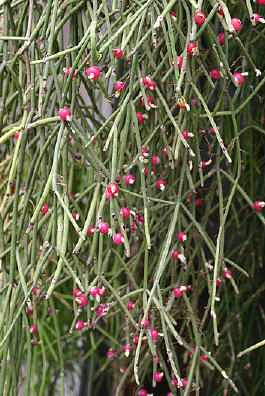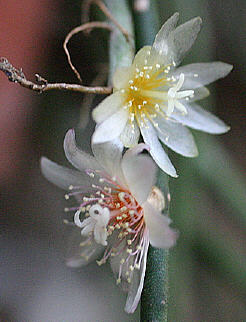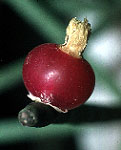|
Rhipsalis neves-armondii
K.Schumann in Martius, Fl. Bras. 4(2): 284. 1890
Desc from B&R 1923
Type locality: Mount Tijuca, Rio de Janeiro, Brazil. Notes from Britton and Rose 1920 There has long been much uncertainty regarding this species and Dr. Rose, during his trip to South America, in 1915, endeavored to solve the problem. He first visited one of the three localities mentioned in the original description, namely Tijuca, a mountain near Rio de Janeiro. Here he found two species which belonged to the same group, Rhipsalis grandiflora and R. pulvinigera. He then visited the herbarium of the Museo Nacional, where he found specimens of R. neves-armondii. Unfortunately, they did not bear an original label but one doubtless written after the appearance of the description in the Flora Brasiliensis for the three localities mentioned therein. After studying this material carefully, he visited the mountain region just above Tijuca, namely Pica Popagaya, where he feels certain he has collected the true form, although the joints are more terete and the flowers are pure white instead of yellow; it is a singular Rhipsalis and a very shy bloomer. A second visit was then made to Tijuca, but lower down on the mountain, and here he again found this species forma neves-armondii Note from Bradleya 13 DISTRIBUTION. Brazil (S & \V Rio de Janeiro, Sao Paulo, Parana, Santa Catarina?): epiphytic and epilithic in Atlantic forest, at <1,000 m altitude. Desc from Hunt 2006.Body pendent up to 2m or more or less erect to sprawling over rocks, pale to dark green; branch segments all determinate, arising in groups of 2-5 or more. naked and perfectly cylindric prior to flowering, the ultimate rounded and ‘blind’ at apex (new branch segments erumpent from the hidden terminal areole), 4-10(-35)cm x 4-10mm; areoles visible only after flowering, woolly; flowers lateral or subapical, 1.4-4cm diam, silvery white to pale pinkish or pale yellow; stamens red or yellow at base; stigma 4-6, up to 3.5mm; fruit globose to depressed, up to6 x 8mm, red Note the two flower-color forms: yellow and pink. These flowers are not on the same plant of course.
|



